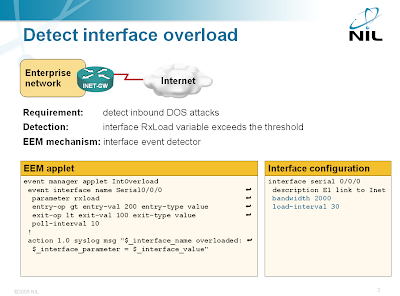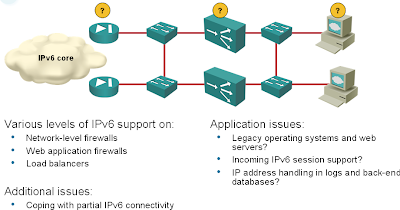HQF: intra-class fair queuing
Continuing from my first excursion into the brave new world of HQF, I wanted to check how well the intra-class fair queuing works. I’ve started with the same testbed and router configurations as before and configured the following policy-map on the WAN interface:
policy-map WAN
class P5001
bandwidth percent 20
fair-queue
class P5003
bandwidth percent 30
class class-default
fair-queue
The test used this background load:
| Class | Background load |
|---|---|
| P5001 | 10 parallel TCP sessions |
| P5003 | 1500 kbps UDP flood |
| class-default | 1500 kbps UDP flood |
Detect DoS Attacks with EEM
Someone sent me an interesting question a while ago: “is it possible to detect DOS flooding with an EEM applet?” Of course it is (assuming the DOS attack results in very high load on the Internet-facing interface) and the best option is the EEM interface event detector.

Detecting interface overload with EEM
The interface event detector is more user-friendly than the SNMP event detector. You can specify interface name and parameter name in the interface event detector; with SNMP event detector you have to specify SNMP object identifier (OID). The interface event detector stores the interface name, measured parameter name and its value in three convenient environment variables that you can use to generate syslog messages or alert the operators via e-mail.
IPv6 in the Data Center: is Cisco ready?
With the recent Cisco’s push into the Data Center environment and all the (not so very unreasonable) fuss around IPv4 address depletion and imminent need for IPv6, I wanted to check whether an all-Cisco shop could do the first step: deploy IPv6 on Internet-facing production servers. If you follow the various design guidelines, your setup will have at least the following elements (and I bet someone from Cisco has already told you that you also need XML firewall, Ironport and WAAS appliance):
Now let’s see how well these boxes support IPv6.
I’m describing the Data Center IPv6 deployment issues in the Enterprise IPv6 Deployment workshop. The diagram above was taken straight from the workshop materials.
First HQF impressions: excellent job
Several readers told me that the Hierarchical Queuing Framework introduced in IOS releases 12.4(20)T and 15.0 (why do I always have the urge to write 12.5?) works much better than CB-WFQ. After spending several hours trying to break HQF, I have to concur with them: Cisco’s engineers did a splendid job. However, the HQF behavior might be slightly counterintuitive to those that became too familiar with CB-WFQ.
Solution: Bandwidth+Police actions in CB-WFQ
Most of the respondents to my last week’s challenge got it almost right. The minor (common) error was the assumption that police rate percent 50 would result in a TCP session getting 50% of the bandwidth. Eyal got that right: the TCP throughput is always significantly lower than that due to frequent drops caused by low burst sizes assumed by the police command and resulting TCP restarts (the most I was able to push through was around 90 kbps; half of the bandwidth would be 128 kbps).
ITU: Grabbing a Piece of the IPv6 Pie?
ITU (the organization formerly known as CCITT) is having a bit of a relevance problem these days: its flagship technological achievements, including X.25, ISDN, ATM, and SDH, are dead or headed toward oblivion … and a former pariah, a group of geeks, is stealing the show and rolling out the Internet. No wonder their bureaucrats are having a hard time figuring out how to justify their existence. For years they’ve been lamenting how much they’ve contributed to the Internet (highly recommended reading for Monty Python fans) and how their precious contributions were unacknowledged. Now they came forth with a “wonderful” idea: the history of IPv4 address allocation proves that the wealthy nations and early adopters managed to grab disproportionate parts of the IPv4 address space (well, that’s true), so they made it their mission to protect the poor and underdeveloped countries in the brave new IPv6 world. In short, they want to become an independent address allocation entity (RIR). It looks like another worldwide bureaucracy is precisely what we need on top of all the other problems we have with IPv6 deployment.
Challenge: CB-WFQ Bandwidth+Police behavior
I have to admit I was somewhat surprised by the lab test results I’ve published in my previous CB-WFQ post. It looks like we’ve been fed misleading information about (classic) CB-WFQ behavior for years.
Don’t tell me that things are completely different with HQF implemented in IOS releases 12.4(late)T and 15.0. I know that … but 95+% of the installed base do not use those releases.
Let’s see whether you can figure out what my next lab test results showed. I’ve been running three parallel TTCP sessions on ports 5001, 5002 and 5003 across a 256 kbit point-to-point link. Here’s the relevant part of my router configuration:
Off-topic: universal engineers
Decades ago when I was still in high school and working on a programming project during the summer break, an IT old-timer gave me the following bit of advice: “Remember, God created professions so that everyone could do the job he’s qualified to do”. It took me years before I understood what he had been trying to tell me, but this seems to be an industry-wide disease. Judging by some of the e-mails I receive a lot of people who are proficient in other IT specialties think they can configure the routers with a little help of good uncle Google and free support from fellow bloggers.
It seems the “ability” of a “generic” IT employee to tackle any problem somewhat related to IT is also unique to our industry. Last week a woodworker was installing my kitchen and flatly refused to connect the electric cable of the ceramic cooktop to the wall outlet citing potential liabilities (please remember: I’m not living in US but in Central Europe). An HTML programmer asked to configure the enterprise firewall might not be so reluctant. Why do you think some people in our industry believe they are universal engineers?
CB-WFQ misconceptions
Reading various documents describing Class-Based Weighted-Fair-Queueing (CB-WFQ) one gets the impression that the following configuration …
class-map match-all High
match access-group name High
!
policy-map WAN
class High
bandwidth percent 50
!
interface Serial0/1/0
bandwidth 256
service-policy output WAN
!
ip access-list extended High
permit ip any host 10.0.3.1
permit ip host 10.0.3.1 any
… allocates 128 kbps to the traffic to/from IP host 10.0.3.1 and distributes the remaining 128 kbps fairly between conversations in the default class.
I am overly familiar with weighted fair queuing (I was developing QoS training for Cisco when WFQ just left the drawing board) and was thus always wondering how they manage to implement that behavior with WFQ structures. A comment made by Petr Lapukhov re-triggered my curiosity and prompted me to do some actual lab tests.
The answer is simple: CB-WFQ does not work as advertised.
Book review: Foundation of Green IT
If you want to understand the real impact of the recent Data Center hype without getting pulled into the technology morass the vendors so copiously spread in their white papers, read the Foundation of Green IT book published by Prentice Hall. Its author, Marty Poniatowski, uses two case studies to illustrate enormous savings that can be realized through server and storage consolidation. I loved the first half of the book: the author avoids the technology issues (I loved the introduction to RAID: “I do not cover RAID background … the Internet has a wealth of information on RAID”) and uses real-life data gathered in actual project to illustrate the savings. Each case study has several chapters, ranging from starting point discovery through implementation plans and ROI analysis; exactly what you need if you’re considering going down the data center redesign path. The “Desktop Virtualization” and “Data Replication and Disk Technology Advancements” chapters are thrown in for good measure.
The author makes the server and storage consolidation case studies even more interesting by describing actual products/solutions and inserting screenshots of actual reports throughout the text. Not surprisingly, he’s describing what he knows best: HP servers, EMC storage and VMware virtualization; a clear indication how far Cisco has to go to win the hearts and minds of the data center market.
IPv6-capable or IPv6-ready: is it enough?
During the IPv6 summit in Slovenia I’ve participated in a roundtable organized by our Ministry of Higher Education, Science and Technology. One of my points was that the government should require true IPv6 support in all its IT procurement processes to promote IPv6 adoption (I have to admit I’ve borrowed a few ideas from Geoff Huston’s “Is the Transition to IPv6 a Market Failure?” article) … and one of the participants (coming from the Service Provider industry) answered that “that’s common hygiene”. I’m not so sure.
Topics like this are covered in my Enterprise IPv6 Deployment workshop. Learn more about my workshops from my web site.
Followup: What’s wrong with the Zone-Based Firewalls book
I’d like to thank all the readers that took time and responded to my question about the failure of my Deploying Zone-Based Firewalls book. The sad short conclusion is: while everyone would love to have an electronic copy of the book, the technology and the mindsets are simply not ready yet. Here are the details:
What’s your take on Alcatel-Lucent IP+Optical integration?
Approximately a month ago Alcatel-Lucent launched Converged Backbone Transformation (are they sharing marketing wizards with Cisco … or is the excessive hype an industry-wide phenomenon?): a visionary(?) convergence of IP and optical technologies. If you haven’t heard about it yet, you could try to start with the IDC report published on Alcatel-Lucent’s web site (I’m always amazed how some people manage to tell so little in so many words).
Once you get past the fluff to the details, it could be that they're implementing a lot of common-sense. For example, it looks like the lambda-level grooming replaces GBIC/SFP transceivers with something that can generate multiple lambdas on the router and feed these lambdas directly into the DWDM gear. In my understanding, it replaces the GE port-GBIC-fiber-GBIC-GE port-lambda generation-DWDM chain with the shorter and cheaper GE port-lambda GBIC-fiber-lambda port-DWDM chain (obviously, I might be completely wrong; it’s hard to deduce the details from a press release).
Anyhow, I’d really appreciate your thoughts on this launch. Does it make sense? How does it compare to what Cisco and Juniper are doing? Is this a move in the right direction … or is Alcatel-Lucent playing a catch-up and trying to cover it with a grand marketecture?
IOS packaging: Moore’s Law Won
Great news: Cisco launched a new series of midrange routers on Tuesday. They're very probably great products (I wouldn't expect less from Cisco). Also as expected, their marketing department couldn’t help itself (yet again) and had to position the launch as a universe-changing event: this time they Revealed the Borderless Network and spent loads of money producing “viral videos”. OK, maybe their average customer is stupid enough to fall for those tricks; I’m positive you’re not … so let’s see what’s really new (here's what Cisco admits is new after you've got past all the marketing fluff):
Help appreciated: what’s wrong with my Zone-based Firewalls book?
A quick question for you: in two years since my Deploying Zone-based Firewalls digital short cut (marketese for downloadable PDF) was published, we’ve sold around 200 copies of it. Obviously we’re doing something wrong and I’d appreciate your opinion: is it the topic (are you using ZB firewall on Cisco IOS?), the format (would you prefer paper copy?), the platform (Cisco IOS as a firewall), pricing ($14.99 for 112 pages) or something else?

